

The Earth orbits the Sun with eight other planets, millions of asteroids, and perhaps trillions of comets. These objects are held in their orbits by the equilibrium motions of their gravitational attraction towards the Sun and a perpendicular velocity away from the Sun. Strictly speaking, these orbits are ellipses, not circles, though the Earth's orbit is very nearly a circle. While the planets may appear to move through the night sky just as stars do, they are also moving in their own orbits around the Sun. Repeated observations, in fact, show that the planets move with respect to seemingly fixed stars in the distant background. The very word "planet" comes from ancient Greek word meaning "wanderer". In this chapter, we will investigate the nature of the objects in our Solar System, their behavior, and their associated phenomena.
By comparison, the Moon's diameter is 3,476 km (0.27 of Earth's), while large for a moon, is rather small compared to most of the planets. It only appears so large in the sky because it is so much closer to us than any planet (an average of 384,405 km).
.
Activity 5-1: Modeling Planetary Sizes
By relating the sizes of the different planets to familiar objects, this activity helps to reinforce the relative sizes of the planets.
Materials: Marble; walnut; golf ball; raisin; acorn; basketball; soccer ball; softball; grapefruit; kidney bean; Post-It pads.
Are all the planets the same size? Is the Moon much smaller than all the planets? Is the Moon a planet? Do other planets have moons? How big should the Sun be on this scale? It should actually be over nine feet across- this is higher than an average classroom ceiling!
Activity 5-2: A Classroom Solar System
If it takes around twelve hundred Earths to fill up Jupiter and about twelve hundred Jupiters to fill the Sun, it becomes difficult to represent this in a model! However, if we imagine the Sun is a ball 9 feet across, we can build a scaled down representation of our solar system.
To make this model, the ceiling of the classroom or nearby room must be able to support a few pounds of weight spread over a small distance. You may want to investigate the strength of the ceiling and its physical ability for attaching a hanging mobile. Paneled tile ceilings are great as they have nooks for hooks, wooden ceilings allow minor hook & eyes to be installed, and rooms with lots of overhead pipes are ideal for slinging strings around. Please consider which method of fixture is best to use before attempting this activity.

The planets of the Solar System fall into two general categories: the terrestrial planets (like the Earth) and the Jovian planets (like Jupiter). The terrestrial planets- Mercury, Venus, Earth and Mars- are relatively small and have rocky crusts and small atmospheres. The Jovian planets- Jupiter, Saturn, Uranus and Neptune- are many times larger and have dense, gaseous atmospheres with no visible surfaces. Because of this, the Jovians are sometimes referred to as gas giants, although it is believed that the cores of these huge planets are liquid if not solid forms of helium and hydrogen. Pluto, the most distant planet, is in a class by itself. It's tiny (only slightly larger than our Moon), its orbit is inclined more than 17 degrees compared to the orbits of the other planets, and its orbit is also very eccentric (its distance from the Sun varies over the course of its orbit). It's so eccentric, in fact, that it even crosses Neptune's orbit, so sometimes Neptune is farther from the Sun than Pluto! For this reason, combined with the facts that Pluto's plane of orbit is several degrees above the planes of all of the other planets and has a moon almost as big as it is, has caused astronomers to reconsider the planetary classification of Pluto and perhaps refer to it as a huge rogue comet instead. The table summarizes the basic physical and orbital data about each of the nine planets of the Solar System.
Planet Distance
(from Sun) Diameter Mercury 57,910,000 km...0.39 A.U. 4,800 km Venus 108,200,000 km...0.72 A.U. 12,100 km Earth 149,600,000 km...1.00 A.U. 12,750 km Mars 227,940,000 km...1.50 A.U. 6,800 km Jupiter 778,330,000 km...5.20 A.U. 142,800 km Saturn 1,429,400,000 km...9.50 A.U. 120,660 km Uranus 2,870,990,000 km...19.20 A.U. 51,800 km Neptune 4,504,300,000 km...30.10 A.U. 49,500 km Pluto 5,913,520,000 km...39.50 A.U. 3,000 km
Discussion
The following objects are appropriate in size to help visualize the relative proportions of sizes of one planet to another:
| Planet | Scale Object |
|---|---|
| Mercury | marble |
| Venus | walnut |
| Earth | golf ball |
| Mars | acorn |
| Jupiter | basketball |
| Saturn | soccer ball |
| Uranus | softball |
| Neptune | small grapefruit |
| Pluto | kidney bean |
Materials: Items listed above, paper maché, paper, pencils, markers, paint, string, long pipe cleaners or thin wire, spherical rubber balloons, and small paper clips.
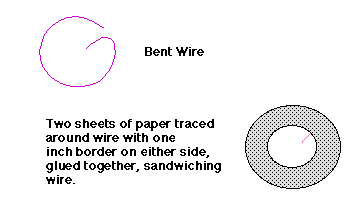 some pipe
cleaner or thin wire into a circle made to the diameter of the rings,
but bend one end of the circle inwards, like the letter G, enough that it reaches
the paper maché ball and can be (but NOT yet!) inserted CAREFULLY into
the side via a hole pricked there by a sharp object. For
sturdiness, students may want to loop two wires and bend the wire on the other side
inwards as well to look like an O with a belt on. Place the ring of
wire on to a big piece of paper folded in half and trace around it --
but 1 inch away from it on both sides, so you make a big
doughnut. Because the paper is folded, you will get two doughnuts. Cut these doughnuts out after painting them as rings, and "sandwich-glue" them around the wire. When the glue has dried, slip the rings over the planet and insert the bent bits into the pricked holes in the side. Glue these bits if necessary. NOTE: Uranus is a planet which is kicked over on its side, so its rings are vertical, not horizontal!
some pipe
cleaner or thin wire into a circle made to the diameter of the rings,
but bend one end of the circle inwards, like the letter G, enough that it reaches
the paper maché ball and can be (but NOT yet!) inserted CAREFULLY into
the side via a hole pricked there by a sharp object. For
sturdiness, students may want to loop two wires and bend the wire on the other side
inwards as well to look like an O with a belt on. Place the ring of
wire on to a big piece of paper folded in half and trace around it --
but 1 inch away from it on both sides, so you make a big
doughnut. Because the paper is folded, you will get two doughnuts. Cut these doughnuts out after painting them as rings, and "sandwich-glue" them around the wire. When the glue has dried, slip the rings over the planet and insert the bent bits into the pricked holes in the side. Glue these bits if necessary. NOTE: Uranus is a planet which is kicked over on its side, so its rings are vertical, not horizontal!
Discussion
Students may see a pattern in the sizes and groupings of the planets. What happens to the size with distance from the Sun? The color? Rings? Which planet does not seem to fit into the pattern? Do students see how Jupiter is the dominant planet? Students should recall what the Sun would look like if placed in their classroom using this scale. It would have to be a sphere nine feet in diameter.
Activity 5-3: Planetary Distances on the Playground In this activity, each student or small group of students represents a planet in order to illustrate the spacing of the planets. The Planetary Data Table at the beginning of these activities lists the distance of each planet from the Sun (in kilometers and astronomical units). By translating these numbers into paces, the students can pace off the distances to the planets.
Materials: Playground or field, letter-sized sheet of paper for each planet, markers.
Discussion
Are the planets evenly spaced? Is there some pattern you can find which seems to fit what is seen? Could you find some mathematical equation which would fit the pattern? How does a planet's distance from the Sun relate to its temperature? Should planets nearer the Sun be hotter or cooler than those farther away? The next activity will help answer this question.
Activity 5-4: Sun and Earth
While Jupiter is the largest of the planets, by far the largest object in our Solar System is the Sun. More than one hundred Earths (109, to be precise) could fit across the Sun. 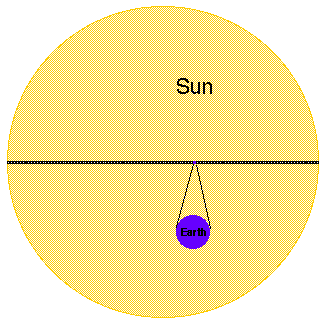 The figure illustrates this size relation. This activity will illustrate this ratio to the class on the playground. The teacher will mark off one pace to represent the diameter of the Earth, while each student will guess how much bigger the Sun is.
The figure illustrates this size relation. This activity will illustrate this ratio to the class on the playground. The teacher will mark off one pace to represent the diameter of the Earth, while each student will guess how much bigger the Sun is.
Materials: Playground or field; letter-sized sheet of paper for each student; rock or brick for each student; markers.
Does it make sense that the Sun should be so much bigger than the Earth? Which has more mass? Which has the stronger gravitational field? You might be tempted to say the Earth, because we can feel it pulling us down, but the Sun's is so great that it pulls the whole Earth!
What would happen if the Earth had as much mass as the Sun? Would the Earth still orbit the Sun? What if it had twice as much mass as the Sun? Could the Earth have other planets orbiting it?
Newton's First Law of Motion states that an object at rest will tend to stay at rest and an object in motion will tend to stay in motion in a straight line, unless acted upon by an external, unbalanced force. If one rolls a ball on a level surface, it will travel in a straight line until the force of friction stops it. There's no air or carpeting to slow the planets in their orbits, but the planets don't travel in straight lines through space. There must be another force acting upon them. That other force is gravity, of course.
When we experience gravity in our everyday lives, the force is usually between two objects of very different masses: one very massive (like the Earth) and another with negligible mass (like a person). Because of this fact, we often simply think of gravity as some property of very massive objects like planets and stars. In reality, though, gravity attracts every object to one another: the Earth pulls on you only as much as you pull on the Earth. Since the Earth is much more massive than you, though, you won't notice the infinitesimal amount the Earth moves towards you, but you can't help but notice how you fall to Earth! There is also gravitational attraction between you and, say, your desk, but neither you nor your desk have enough mass so the force is noticeable. The gravitational force between two bowling balls can be measured in the laboratory with very sensitive instruments, however!
It is gravity which keeps the planets in orbit about the Sun, the Moon and artificial satellites about the Earth, and the Sun about the center of our Milky Way galaxy. In the case of the planets, the force of gravity is analogous to the tension in a string tied to a ball being swung overhead. The swinging is the velocity of the planet perpendicular to the tug of gravity from the sun. The planet (or ball) is kept in orbit by the tug of the Sun (string), and if it were to stop (or if the string were broken), the planet (or the ball) would fly away in a straight line .
By analyzing the observations of Tycho Brahe, a Danish astronomer of the sixteenth century, Johannes Kepler realized that the orbits of the planets about the Sun were not perfectly circular, as had been believed (mainly for aesthetic and religious reasons) for centuries. Rather, the planets orbit the Sun in ellipses, a class of geometric figures of which the circle is a special case. An activity in this Topic is devoted to drawing ellipses.
We also explore retrograde motion, a consequence of the fact that those planets closer to the Sun move through their orbits more quickly then those farther away.
Activity 5-5: Drawing Ellipses
We stated earlier that all orbits are ellipses. But what are ellipses? Ellipses look like ovals, but are very specifically defined mathematically. Technically speaking, ellipses are members of a special class of geometrical shapes known as conic sections. They are so named because all of these shapes (circles, ellipses, parabolas, and hyperbolas) can be made by slicing a cone with a plane. 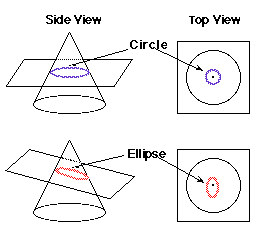 The figure to the right illustrates this process for the circle and the ellipse. You might want to demonstrate this to the class by cutting solid cones (like miniature Styrofoam tree forms) at different angles and examining the resulting cross sections.
The figure to the right illustrates this process for the circle and the ellipse. You might want to demonstrate this to the class by cutting solid cones (like miniature Styrofoam tree forms) at different angles and examining the resulting cross sections.
A circle is defined such that every point on a circle is the same distance from the center. One can easily construct a circle by tying a pencil to a string, securing the string to the paper with thumbtack, and keeping the string taut while moving around the thumbtack. The string is the radius and the thumbtack marks the center. An ellipse is somewhat more complicated to define and construct. Instead of one point of interest, the center, there are two points, the foci (singular: focus). The sum of the distances from each point on an ellipse to the two foci is a constant.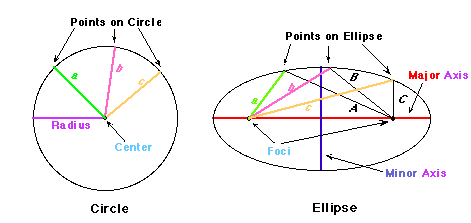
The farther apart an ellipse's foci are, the more eccentric it is said to be. A circle is just a special case of an ellipse; if the two foci are at exactly the same place, the ellipse is a circle. The Earth's orbit is very nearly a circle. If it were very eccentric, the distance from the Earth to the Sun throughout the year would vary a great deal more than it does. This could make the Sun appear much larger when we were closer and much smaller when we were farther away. It would also vary the amount of light and heat the Earth receives from the Sun. While we do experience warmer and cold seasons, it is not because the Sun is closer or farther. In fact, the Earth is slightly closer to the Sun in its orbit during the Northern Hemisphere's winter than during the summer. For more information about the seasons, see Chapter 1.
Despite the rather unusual and precisely mathematical way we have defined the ellipse, it's really very easy to construct. Terms like "eccentricity" will gain more meaning as the students experiment with different distances between the foci.
Materials: Thick cardboard or plywood; paper; string; sharp pencil, thumb tacks.
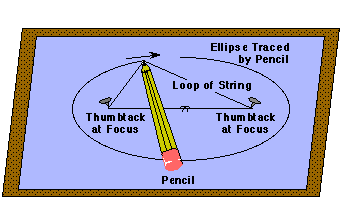
With only one thumbtack, the figure is a circle. A circle, then, can be said to be a special case of an ellipse. This is a common way of grouping shapes; a square, for instance, is just a special case of the rectangle, in which two adjacent sides are of equal length. This may be a good place to mention group theory to older students, if such basic logic is in the curriculum ("If all circles are ellipses and all ellipses are smooth figures, does that imply that all smooth figures are circles?").
Activity 5-6: Planetary Distances on the Playground
In this activity, each student or small group of students represents a planet in order to illustrate the spacing of the planets. The Planetary Data Table at the beginning of this chapter lists the distance of each planet from the Sun (in astronomical units). By translating these numbers into paces, the students can pace off the distances to the planets.
Materials: Playground or field; letter-sized sheet of paper for each planet; markers.
Are the planets evenly spaced? How does position relate to temperature? Should planets nearer the Sun be hotter or cooler than those farther away? The next activity will help answer this question.
Activity 5-7: Sunlight Near and Far
As we have seen, the planets are in orbits of greatly varying distance from the Sun. Since the Sun is the sole energy source for the entire Solar System, a planet's distance from the Sun can have profound effects on its composition, atmosphere, and climate. This activity helps to demonstrate that as one moves farther from a light source, the less energy one receives from it.
Materials: Graph paper; cardboard or plywood; masking tape; flashlight; markers.
Is there any relation between the distance the flashlight is from the paper and the number of squares its light covers on the paper? What does this mean about sunlight reaching the outer planets? What does that mean about planets like Mercury or Venus? Remember this activity when we learn about comets, for it will explain why we cannot see them far away but can when they get closer to the Sun.
Activity 5-8: Earth and Sun Revisited
Being the third closest planet to the Sun may make our home seem nice and cozy, but does it have any disadvantages? Besides making us more prone to collisions with comets and meteoroids (see Topic 4), it also means we get more of the brunt of the radiation from the Sun. Solar radiation comes in many forms, most of which are undetectable;e to the human body. One of these is the solar wind, a stream of particles coming from the Sun. Luckily for us, the planets have magnetospheres, or shells of magnetic force fields around them. The particles screaming from the Sun are charged particles which are attracted to the magnetic force field. Like a big bar magnet, the Earth collects most of these particles to its poles where we see their entry in auroras or in bad television reception.
Materials: bar magnet, drinking straw, two sheets of notebook paper, iron filings
The force field around the bar magnet is like any other magnet: looping from the poles of the magnet like a coffee cup with millions of handles. This makes the iron filings surround the magnet in the same way and make the solar wind particles do likewise on the Earth.
What would change the pattern of the filings? What if someone were blowing air low across the table top perpendicular to the one blowing from the straw? Would this explain why Jupiter's magnetosphere extends past the planet Saturn behind it?
Activity 5-9: Retrograde Motion
As we mentioned in the introduction to this chapter, the planets appear to move with respect to the much more distant "fixed" stars. In fact, we even get our word "planet" from a Greek word meaning "wanderer". Beyond simple "wandering" due to the planet's orbit, sometimes the apparent motion of the planets across the sky can seem quite elaborate and surprising. We should expect that if we look at a planet each night, it should move a little with respect to the stars around it due to differences in the orbital speeds of the planets; a planet closer to the Sun completes an orbit in less time that one more distant. 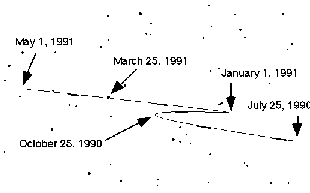 Because of these differences, faster planets (closer to the Sun) routinely catch up to and overtake slower planets (farther from the Sun). Viewed from the faster planet, the slower planet would appear to move backwards during the time the fast planet passes the slower planet. We will attempt to demonstrate this effect on a long table or window sill in the classroom.
Because of these differences, faster planets (closer to the Sun) routinely catch up to and overtake slower planets (farther from the Sun). Viewed from the faster planet, the slower planet would appear to move backwards during the time the fast planet passes the slower planet. We will attempt to demonstrate this effect on a long table or window sill in the classroom.
Materials: Toy car or truck; long table near window or window sill; office chair with wheels.
If one travels at a constant rate, one does not feel the motion. Does it feel like you're moving in the middle of an elevator ride? on an escalator? in a car at a constant speed on a smooth road? Since we don't feel that the Earth is moving, it looks like anything we pass (like Mars) is actually moving backwards! What would happen if the toy car were moving faster than the student's chair?
Each of the planets in our Solar System has its own unique character, from the acid rains of Venus to the lightning storms on Jupiter. One thing common to almost all of the planets is an atmosphere. Mercury and Pluto are the only two planets which have no atmosphere. The rest have gas layers spanning from tens of miles to hundreds of thousands of miles thick.
To hold on to an atmosphere, a planet must have either enough mass to keep the gas in place preferably with a continuing supply of the gas, or be far enough away from the Sun to keep the gas from boiling away into space.
Venus, a planet closer to the hot Sun than the Earth yet smaller in size than the Earth has a greater atmosphere than the Earth. This is due to the fact that its atmosphere is primarily carbon dioxide. This gas built up because Venus was too close to the Sun for any large oceans to form and remain; oceans on the Earth absorb the carbon monoxide and transform it into mineral deposits, primarily found in shellfish. An incredible quality of a carbon monoxide atmosphere is that it can trap heat to the planet's surface. The thick atmosphere has provided Venus with surface temperatures of over 700¡F and surface pressures of over 90 Earths. For years, no one could see below the reflective cloud tops of Venus until radar probes were sent to its surface. Radar is a technique of mapping a hidden surface by sending sound waves to the surface and timing their return bounce upward to the spaceship. This has been a highly successful way of "seeing" the world below the clouds of Venus. we have found from this mapping that Venus has old volcanoes, continental plates, and lots of cracks across its surface.
Activity 5-10: Radar Mapping an Aquarium
Without the use of multi-million dollar equipment and traveling to other planets, it is easy to use the idea of radar mapping in the classroom.
Materials: A large aquarium, black construction paper or black paint, paper maché, random sturdy objects, string, meter stick, pencil, notebook with graph paper pages.
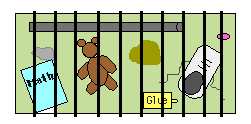 Students should measure the depth of the tank with a meter stick. They will need this value to determine the height of the objects to be placed inside. A group of students and/or teachers should create a landscape inside the dry aquarium with objects of their choice and paper maché. It should not be too crowded nor too sparse, on average one object per 2 square inches.
Students should measure the depth of the tank with a meter stick. They will need this value to determine the height of the objects to be placed inside. A group of students and/or teachers should create a landscape inside the dry aquarium with objects of their choice and paper maché. It should not be too crowded nor too sparse, on average one object per 2 square inches.
Discussion
Is it possible to determine where there are bumps and where there are holes? When looking at both the lengthwise and the shortwise graphs, is it possible to determine where some object spreads into another band? How could a larger three-dimensional map be created from the data? Try to recreate the mystery landscape with clay or paper maché. Take down the tank and look inside to compare results. Is this method of measuring an otherwise hidden planet useful? What are its limitations?
Activity 5-11: Why is the Sky Blue?
The age old question posed to adults by curious children, a question often reflected upon by the adult as well. So here it is asked again, this time with an answer which is fun to discover.Why is the sky blue?
The atmosphere of the Earth is made of several gases, the most common being nitrogen and then oxygen. Chemically speaking, eventhough the human eye cannot see them unaided, these gas molecules are large. The light from the Sun is white light, a combination of a rainbow of colors (see light section). The bluer light is light which travels in smaller packets than does the redder light. When the white light hits the atmosphere, the particles of light hit the large molecules of air. The bigger light packets, the red, oranges, yellows, and some greens are able to bump their way through the molecules and pass to the ground. However, much of the smaller light packets, the blue light and some green, get stuck bouncing around the big molecules like a pinball around the bumpers. Thus, the sky looks blue for the blue light stuck high in the atmosphere and the sunsets look red for the red light being able to pass straight through at the point of light (the Sun).
The effect of reddening can be seen in different places across a town. In the most polluted part of town, the sky looks very red. This is because there are particles of dust, waste, and water in the sky, particles large enough to scatter even the largest of light packets like the red ones. Deep blue skies, in contrast, are clean, dry areas where only the really small packets of light, the blue and violet, are stuck in the highest parts of the atmosphere.
This activity allows the reddeing effect to be explored using simple household objects.
Materials: A bright flashlight, drinking glass, eye dropper, milk, spoon
Discussion
A planet with no atmosphere would have a sky which was black and a surface which was bathed in sunlight. Take notice of the Apollo astronaut photos on the Moon to see this effect. The lack of atmosphere allows all of the light to pass right down to the surface, just like the flashlight beam through the water. However, if there is an atmosphere with big molecules in it, or a glass of water with big particles of milk in it, the blue light gets scattered and the redder light does not. The light coming through the glass with milk is redder and the glass of watered milk looks bluer.
What could this mean about the sunsets after a volcanic eruption? What would the sky look like on Mercury?
Activity 5-12: Modeling Jupiter's Atmosphere
Sometimes atmospheres can be more a bane than a boon, as in hurricanes and tornadoes. There are planets whose atmospheres never rest and are constantly churning. 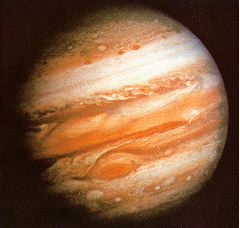 Since Venus spins on its axis in the opposite direction it goes around the Sun, its winds are constantly roaring across its surface. On Jupiter there is a hurricane which has raged for at least three hundred years and is occasionally dark red. Is this because of the reddening effect above or something else? Actually, Jupiter's clouds are made of different molecules than on the Earth, molecules like methane and sulfur. These are elements which have different colors with different temperatures. With several layers of these gases over thousands of miles of atmosphere, it is possible to trace depths of Jupiter's atmosphere simply by examining the colors.
Since Venus spins on its axis in the opposite direction it goes around the Sun, its winds are constantly roaring across its surface. On Jupiter there is a hurricane which has raged for at least three hundred years and is occasionally dark red. Is this because of the reddening effect above or something else? Actually, Jupiter's clouds are made of different molecules than on the Earth, molecules like methane and sulfur. These are elements which have different colors with different temperatures. With several layers of these gases over thousands of miles of atmosphere, it is possible to trace depths of Jupiter's atmosphere simply by examining the colors.
Materials: Developing paper, double sided tape, cardboard, scissors
Discussion
The developing paper is designed to turn very dark when light hits its surface. The chemicals of the paper react to sunlight and darken, like getting a tan. Without the sunblock, or the cardboard shape, the paper gets a sunburn. Since Jupiter's clouds are made of chemicals which also react to the light and heat of the Sun, they are different colors depending on what's blocking them or how deep they are.
What does this say about the stripes of Jupiter? Or the Great Red Spot? What about storms on other planets?
Activity 5-13 : The Great Red Spot
The  churning nature of Jupiter's clouds is suspected to be the result of the planet's hot core which is still trying to cool off. Not unlike Earth's volcanoes, the planet Jupiter needs a method by which it can release heat. It does so by radiating it out through its enormous atmosphere. Strangely, the bands one sees across the planet's atmosphere are due to layers of gases blowing past each other in opposite directions. Thus, the vortex of the Great Red Spot is not too surprising with such terrible weather patterns!
churning nature of Jupiter's clouds is suspected to be the result of the planet's hot core which is still trying to cool off. Not unlike Earth's volcanoes, the planet Jupiter needs a method by which it can release heat. It does so by radiating it out through its enormous atmosphere. Strangely, the bands one sees across the planet's atmosphere are due to layers of gases blowing past each other in opposite directions. Thus, the vortex of the Great Red Spot is not too surprising with such terrible weather patterns!
Materials: Glass jar almost filled with water, tea bag, long pencil
From this activity, is it possible to determine what the section of atmosphere near the Great Red Spot looks like from a side view and from the top? Compare this with the photos of Neptune. What would happen if the water were a flowing river? Would the swirl stay circular or would it spread out? How does this compare to the annual Saturn storms?
Activity 5-14: Rings and Things
The most beautiful aspect of the outer planets is their rings. Each of the gas giants, Jupiter, Saturn, Uranus, and Neptune, all have rings of some kind. Although these rings are made from the tiniest chunkcs of dust and ice, they still appear very bright to the cameras. How could such tiny particles so far away in space be so visible?
Materials: Flashlight, baby powder in a plastic squeezebox, ice cubes, drinking glasses, hot water
Discussion
Before the powder is released, the beam of light is hard to see, like the rays of sunlight through empty space in the Solar System. Since the human eye can only see light if it bounces off of something and into the eye, the beam is hard to see until the powder particles are tossed into it. The particles fly around and bounce the light to the eye. The particles, although tiny, are mirrors for the eye to see reflected light from the Sun and are therefore quite bright.
The particles of the rings are small pieces of ice and dust, but what if they were larger pieces? Would they be as bright? The second part of the activity shows that a large solid ice cube is very clear, or as we learned from the Sky is Blue activity that means lots of light is traveling through it and not getting stuck inside. The broken ice cube looks very white and bright. This is because where there once was a solid cube there is now jagged fractures for light to bounce off of. The rings of planets are made of broken pieces of ice and dust which have lots of jagged surfaces, making them all the more brilliantly bright.
"Wow! Hey, look over there! I just saw a bright streak in the sky! Are the stars falling?" This is often heard in the countryside on clear nights. Falling stars, or "meteors", are not stars at all. Now that the past exercises have shown how large stars like the Sun really are, it would be impossible to imagine something that big just zooming across the sky! Meteors, so named because they happen in the atmosphere (where meteorology got its name), are actually bits of fast flying space debris which has rammed into the Earth's atmosphere, causing enough friction to burn up and sometimes explode (then, called bolides). The "meteor showers" are times during the year when there are an unusually large number of meteors streaking across the sky. The table below shows you the seasonal showers. How can we create a table like this? We have to understand what causes the showers, and that is comets and asteroids.
Earlier we mentioned how asteroids were also planetesimals orbiting in a belt around the Sun and that each asteroid had its own unique orbit. Sometimes, this seemed organized system of planetesimals can get chaotic, perhaps by the orbit of a large comet which disturbs the order, and asteroids will be knocked out of the belt or collide with each other sending fragments out of the belt. These fragments are then collected onto the surfaces of passing comets or roam about the inner Solar System occasionally coming close enough to Earth to collide with it, burning up in the atmosphere completely or leaving pieces large enough to hit the surface. Many get caught in the ring systems of the large gas giants.
It is estimated by astronomers that our solar system has 1 trillion comets, 1,300 of which have been discovered. Comets are planetesimals which orbit so very far away from the sun that very little sunlight reaches them. They are thus made mostly from ices. As they have orbited around the sun for billions of years, they have collected interplanetary debris, leftovers from the planet-making process, mostly fragments of asteroids, onto their surfaces like snowballs rolled down a sandy sidewalk. Billions of years of accumulation of ice and dirt and more ice has created the comets as we observe them -- "dirty snowballs", as comet expert Fred Whipple described them.
The  orbits of the comets are as erratic compared to the orbit of Pluto as Pluto's orbit is the orbits of the planets. Most of their orbits are ellipses, but with one end very close to the sun and the other well out beyond the orbit of Pluto. Periodic comets are known to take from 3 to 1,000 years to complete their orbits around the Sun. Halley's Comet is a periodic comet which orbits the sun about once in a 76 year period; the next time Halley's comet will be visible is in the year 2062, as it was just visible in 1986. Ancient people feared comets, and thought comets were omens of good or evil. The ancients connected them with any major disaster occurring at that time on the Earth and thought the comet had caused it.
orbits of the comets are as erratic compared to the orbit of Pluto as Pluto's orbit is the orbits of the planets. Most of their orbits are ellipses, but with one end very close to the sun and the other well out beyond the orbit of Pluto. Periodic comets are known to take from 3 to 1,000 years to complete their orbits around the Sun. Halley's Comet is a periodic comet which orbits the sun about once in a 76 year period; the next time Halley's comet will be visible is in the year 2062, as it was just visible in 1986. Ancient people feared comets, and thought comets were omens of good or evil. The ancients connected them with any major disaster occurring at that time on the Earth and thought the comet had caused it.
Due to their highly elliptical orbits, comets swing out quite far from the sun but also orbit extremely close to the sun. When a comet begins to get closer to the sun, the sun's radiation begins to evaporate the ice off of the surface of the comet, leaving bits of dirt to float off. The comet then is said to have three structure elements: the nucleus, the coma, and the tails. The nucleus is usually from one half to thirty miles in diameter and is the original "snowball". The envelope of gas (many times half of a million miles in diameter) and dust sublimating (changing from solid ice to gas) off of the nucleus by the radiation of the sun is the coma. and the stream of material being blown off by the solar wind or being left behind as the comet moves along its orbit are the tails.
When the Earth in its orbit about the sun passes through the trail of sublimated particles left behind by the comet, it rams into these floating particles, and we call the spectacular friction burn of their impact with the atmosphere meteors. Most meteors never reach the ground, instead burn up in the Earth's atmosphere in nature's fireworks show. But some do hit the Earth's surface and we call these meteorites. Several tons of meteorites hit the earth every day, most in the form of micrometeorites, tiny flecks of space stuff. From analysis of meteoritic particles, we have found that asteroids are mostly made of rocks like the surface of the Earth or are made up primarily of iron, like the core of the Earth, yet as old as the Solar System -- 4.5 billion years old!
Meteor showers occur when the Earth is traveling through a particularly dense trail of leftover comet material. Since man has been observing and recording the changes in the heavens, we are able to pinpoint the dates and the comet responsible for the meteor showers. The table below shows you the major meteor showers and in what constellation to look for the streaks. The "radiant" is the point in the sky from which all of the streaks seem to be coming -- in other words, the direction of the comet trail!
A  typical Taurid shower will have many very bright meteors, some that give off so much light that their shadows fall on earth. These are called fireballs. If the fireballs explode in midair, they are known as bolides. Witnessing a bolide is quite rare, but spectacular.
typical Taurid shower will have many very bright meteors, some that give off so much light that their shadows fall on earth. These are called fireballs. If the fireballs explode in midair, they are known as bolides. Witnessing a bolide is quite rare, but spectacular.
Leonids usually radiate from the curved "sickle" part of Leo. These meteors peak every 33 years, the next one to be in 1999, with numbers of observed streaks reaching 10,000 per hour. The Leonids are not so reliable, but they can be quite amazing when they are highly visible. November of 1833 is famous for the Leonid shower, during which 200,000 meteors were seen in an hour. People thought that all the stars were falling from the sky and that the world was coming to an end.
Quadrantids (first named for an old constellation now found in Bootes) are characteristically faint blue. To see them turn to the northeast and look up almost 90 degrees.
The radiant of the Lyrids is near the star Vega, in the constellation Lyra.
Eta Aquarids are yellow meteors with trails that glow - actually they are the resultant matter left from Halley's Comet.
The dates in this table may not exactly coincide with these showers. It is best to look a couple of days before the dates given and a couple of days after the last. The most reliable meteor showers are the Perseids, Geminids and Quadrantids .
Students may find it helpful to know that the ancient people feared natural phenomenon since they themselves have many fears. They often feel fearful because so much is unknown to them. They may be helped to discuss their own fears and what helps them to alleviate them. Learning about the world such as scientists or students do helps to alleviate fears, clear up misconceptions and increase knowledge.
Activity 5-15: Watching Meteor Showers
Materials: Tables of Meteor Showers, telescopes, binoculars (optional).
Are there other objects to find in the sky? How helpful is it to spend longer periods such as an hour viewing the sky?
Activity 5-16: Collecting Micrometeorites
Micrometeorites which are iron flecks can be collected by simply using a magnet. The next exercise allows students to collect their own ancient fragments of the Solar System. This activity can be performed on school ground where rain gutters are present or at home. To raise the odds of a significant find, plan this activity during a time of year when there are meteor showers occurring.
Materials: Alnico Magnet or strong bar magnets; plastic bags large enough to wrap around magnets; Petri dishes, 3x5 index cards, crayons, microscope, distilled water (optional).
Does this activity help students understand more about the workings of the inner Solar System? How do the students feel about their ability to do research experiments with the success/failure of this one? How could they use this type of activity in a Science Fair project? Could students be able to make their own meteor shower table from repeating this experiment throughout the year? Why are we able to obtain these micrometeorite particles? Are any students feeling uneasy about the amount of material which is falling on top of their houses/school? Why did ancient people fear comets? What might have helped them to become less fearful? What helps people to become less fearful of natural events and life experiences? How does learning about the cosmos help people to make sense of the world in their lives?
Activity 5-17: Building Extraterrestrials
The possibility of life on other planets, moons and asteroids has captured our imagination almost as long as we have gazed heavenward. These questions still intrigue us, and are undoubtedly all the more fascinating to students who are only recently becoming aware of their place in the Universe. As we shall see, it is unlikely that there is any life as we know it in the Solar System.  Clearly, little green men are not planning a raid from Mars, despite what some popular science fiction may want us to believe. After we explore the atmospheres and surface conditions in our Solar System, this activity challenges the students to invent and build a creature specifically adapted to live in a certain environment on the Earth.
Clearly, little green men are not planning a raid from Mars, despite what some popular science fiction may want us to believe. After we explore the atmospheres and surface conditions in our Solar System, this activity challenges the students to invent and build a creature specifically adapted to live in a certain environment on the Earth.
Materials: Paper or Styrofoam cups; tongue depressors; pipe cleaners; construction paper; glue or paste; assorted craft material.
How might life on Earth be different if it were 100 degrees colder? hotter? What if there were no oxygen in the air? Opposite to us, plants take in carbon dioxide and give off oxygen.
What might happen if a Mars creature were put on Venus? What if a Sun creature wound up on Pluto? What would an Earthling need to survive on the Moon? What do humans need to survive in general? What kind of planets are most likely to support human-like life? What might we first look for if we were looking for a planet which could support us?



 Back to top
Back to top
 | Home
| Home